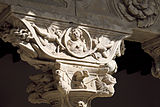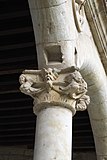Convento de las Dueñas
The Convento de las Dueñas in Salamanca in the province of the same name in the Spanish Autonomous Region of Castile-León is a Dominican convent that has existed since the 15th century. The cloister , whose builder Rodrigo Gil de Hontañón is considered, has an extraordinary sculptural decoration in the Plateresque style . In 1921 the monastery was declared a monument ( Bien de Interés Cultural ).
history
The foundation of the monastery is evidenced by a document from 1419, in which it is referred to as Monasterio de Santa María de la Consolación de las Dueñas . In it, Juana Rodríguez confirms the donation of her palace and the buildings belonging to it to the sisters of the Dominican order , who set up a monastery for noble ladies ( duenas ) there. The palace had been built by Juana's first husband, a converted Jew and grandfather of Isaac Abrabanel , who had taken the name Juan Sánchez de Sevilla and served as treasurer of John I of Castile . Few remains of this palace have survived, such as a brick- walled, horseshoe- arched doorway in Mudejar style on the upper floor of the cloister. Another door frame was rediscovered in 1963 and is exhibited on the ground floor in a wing of the cloister. Part of an artesonado ceiling has also been preserved.
Further donations, including from the Catholic Kings , made it possible to build the monastery church and the cloister in the 16th century. The cloister was part of the cloister of the monastery for over 400 years and was not open to the public. It has only been open to visitors since 1962.
Monastery church
The Gothic style church has a single nave and is covered by a ribbed vault. The altars are from the baroque period.
The plateresque portal of the church is attributed to Juan de Álava, a pupil of Rodrigo Gil de Hontañón . It is divided into three zones. The lower zone is of two, with intricately carved capitals decorated pilasters and overlying beams framed. A round arch opens in the middle, decorated with arabesques and reliefs of animal and human heads. Figures were originally placed in the side niches crowned with canopies. The middle zone is framed by two slender columns and an entablature with a frieze of angel heads. It is broken up by an arcade , in the center of which stands a figure of the Madonna with a child. The medallions of the arcade spandrels depict the apostles Peter and Paul . There are volutes on the side and two coats of arms cartouches , of which the right contains the coat of arms of the Dominican order. The upper end is formed by a shell held by angels putti .
Cloister
The cloister is built over an irregular pentagon and has two floors. The galleries on the lower floor are supported by slender columns that are connected by segmental arches . The pillars are decorated with finely crafted capitals, on which mostly foliage with small heads of people, animals or mythical creatures is depicted. The arch gussets are provided with 23 medallions. Fifteen medallions show male busts, eight depict female busts. The clothes, hairstyle and facial expressions of those portrayed are imaginative and worked out with great attention to detail.
The upper floor has no arches, the ceiling is supported by an architrave that rests on the columns of the upper galleries. These are equipped with twice the number of columns as the ground floor. The capitals are adorned with grotesques and carved with an exuberant decoration rich in figures, on which angels, dragons and mythical creatures seem to be involved in a battle with terrifying gestures. A frieze of medallions runs above the capitals on the outside and inside, in which people, flowers and coats of arms of the Dominican order are depicted alternately. In addition to martyrs holding instruments of torture or palm branches in their hands, you can see monks who can be recognized by their robes, young women, wildly gesticulating warriors and saints, hands raised in blessings. The apostle Peter is shown with his keys, Moses with the tablets of the law, King David is playing the harp. The two medallions with the Archangels Gabriel and Mary are reminiscent of the Annunciation scene, another medallion shows Mary with the baby Jesus in her arms. The sculptor who created the sculptural jewelry is not known.
Capital in the cloister with sheet mask
literature
- María Eugenia Maeso: Convento y Claustro Dominicas Dueñas Salamanca . Ed. MM. Dominicas Dueñas, 5th edition, Salamanca 1999.
Web links
Coordinates: 40 ° 57 ′ 40 " N , 5 ° 39 ′ 48.8" W.










